Chola dynasty architecture is one of India’s most stunning contributions to world heritage. These awe-inspiring temples, built between the 9th and 13th centuries, are not just places of worship—they are masterpieces of engineering, art, and spiritual philosophy. From towering vimanas to detailed stone carvings and massive bronze statues, these architectural wonders continue to captivate travelers and historians alike.
In this blog, we take you on a journey through 8 unforgettable Chola temples that define South Indian temple architecture. Whether you’re a history buff, architecture lover, or simply planning your next heritage trip, this guide is packed with inspiration.
- What Is Chola Dynasty Architecture?
- Key Features of Chola Dynasty Architecture
- 8 Must-Visit Marvels of Chola Dynasty Architecture
- 1. Brihadeeswarar Temple (Thanjavur)
- 2. Gangaikonda Cholapuram (Ariyalur District)
- 3. Airavatesvara Temple (Darasuram)
- 4. Tiruvalisvaram Temple (Tirunelveli District)
- 5. Konerirajapuram Temple (Konerirajapuram)
- 6. Nageswaran Temple (Kumbakonam)
- 7. Thirubhuvanam Temple (Thirubhuvanam)
- 8. Vijayanagara Temple (Kanchipuram)
- Final Thoughts
- FAQs
What Is Chola Dynasty Architecture?
The Chola dynasty, which ruled large parts of South India for over four centuries, is credited with developing a unique and sophisticated architectural style. Their temples were designed not only as places of divine worship but as centers of education, culture, art, and community life.
Key elements of Chola temple architecture include:
- Majestic vimanas (towering superstructures)
- Detailed stone carvings and bas-reliefs
- Exquisite bronze sculptures
- Symmetry and astronomical alignment
- Innovative water tanks and reservoirs
One shining example is the Brihadeeswarar Temple in Thanjavur, a UNESCO World Heritage Site and one of the tallest and most complex temple structures in India.
Top 8 Architectural Wonders of the Chola Dynasty
Here are eight iconic Chola temples that showcase the grandeur of this golden era:
| Temple Name | Location | Key Architectural Features |
|---|---|---|
| Brihadeeswarar Temple | Thanjavur | 66-meter vimana, granite structure, giant Nandi statue, UNESCO World Heritage Site |
| Gangaikonda Cholapuram | Ariyalur District | Artistic carvings, elevated sanctum, large Nandi and Shiva lingam |
| Airavatesvara Temple | Darasuram | Chariot-shaped base, miniature sculptures, intricate mandapas |
| Tiruvalisvaram Temple | Tirunelveli District | Massive halls, excellent acoustics, inscriptions from the Chola period |
| Konerirajapuram Temple | Konerirajapuram | One of the largest bronze Nataraja statues in India |
| Nageswaran Temple | Kumbakonam | Aligned with equinox sunrise, chariot-style layout, fine carving |
| Thirubhuvanam Temple | Thirubhuvanam | Vimana with multilayered carvings, exquisite stone craftsmanship |
| Vijayanagara Temple | Kanchipuram | Ornate gopurams, spiritual setting, influence of later dynasties blending with Chola style |
Key Features of Chola Dynasty Architecture
1. Vimana (Temple Tower)
The vimana, or temple tower, is one of the most defining features of Chola architecture. These structures rise steeply above the sanctum and symbolize the cosmic axis. The Brihadeeswarar Temple’s vimana is 66 meters high and was constructed without modern tools—an unmatched engineering marvel of its time.
2. Intricate Stone Carvings
From gods and dancers to animals and epic scenes, every inch of Chola temples is filled with detailed carvings that narrate stories from the Ramayana, Mahabharata, and Shaivite traditions. The Airavatesvara Temple at Darasuram is especially famous for its storytelling through sculpture.
3. Massive Nandi Sculptures
Nearly every Shiva temple from the Chola period features a colossal Nandi bull sculpture. Carved from single granite blocks, these statues often face the main deity and are intricately detailed. The Gangaikonda Cholapuram Nandi stands out for its scale and expression.
4. Bronze Sculptures
The Cholas perfected the lost-wax technique for creating bronze idols. Their bronze images—especially of Lord Shiva as Nataraja—are considered among the finest in Indian art. You can witness this at the Konerirajapuram Temple, home to one of the largest Nataraja bronzes.
5. Water Reservoirs and Tanks
Chola temples were more than just spiritual spaces—they were models of urban planning. Many, like the Brihadeeswarar Temple, include massive tanks and reservoirs for ritual use and water conservation, reflecting the Cholas’ environmental foresight.
6. Symmetrical Design and Alignment
Temples like Nageswaran Temple are designed so sunlight enters the sanctum during equinoxes—a testimony to the Cholas’ deep understanding of astronomy and geometry.
7. Grand Gopurams (Temple Towers)
Although more prominent in later periods, some Chola temples feature ornate gopurams (entrance towers) filled with carvings of gods, guardians, and celestial beings—often painted or decorated with gold leaf.
8. Decorative Mandapas (Pillared Halls)
The mandapas, or pillared halls, were designed as spaces for religious discourse, music, and festivals. The Tiruvalisvaram Temple’s mandapas are famous for their sculptural finesse and rhythmic acoustics.
8 Must-Visit Marvels of Chola Dynasty Architecture
1. Brihadeeswarar Temple (Thanjavur)
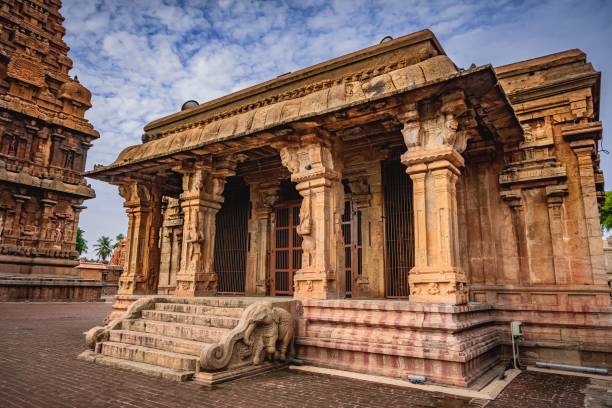
Built in 1010 AD by the great Chola king Raja Raja Chola I, the Brihadeeswarar Temple in Thanjavur is one of the most iconic landmarks in South India. Recognized as a UNESCO World Heritage Site, this grand temple is famous for its towering vimana (main tower), which rises over 200 feet high. Crafted entirely from granite, the temple showcases incredible craftsmanship through its detailed carvings and massive stone structures.
One of its most striking features is the giant Nandi statue—measuring 13 feet tall and 16 feet long—carved from a single rock. The temple walls are adorned with ancient Tamil inscriptions that offer a glimpse into the life and culture of the Chola era. Whether you’re a history lover, architecture enthusiast, or spiritual traveler, this temple is a must-visit gem that continues to inspire awe even after a thousand years.
2. Gangaikonda Cholapuram (Ariyalur District)
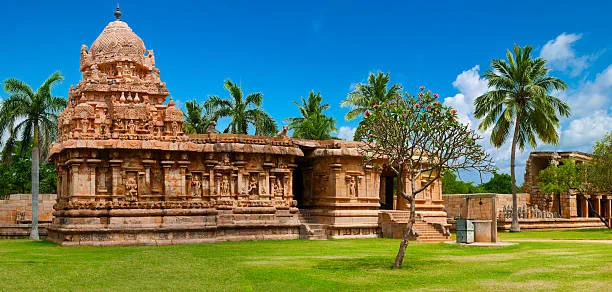
Commissioned by Rajendra Chola I in the 11th century, Gangaikonda Cholapuram was built to match—and even surpass—the grandeur of the Brihadeeswarar Temple. This majestic temple, located in Tamil Nadu’s Ariyalur district, served as the Chola capital for over 250 years and stands as a powerful symbol of their legacy.
The temple features a towering vimana that rises 55 meters high, along with a massive Nandi statue carved from a single stone. But what truly sets it apart is the intricate stonework—some of the finest examples of Chola-era craftsmanship. From detailed sculptures of deities to ornate pillars, every inch of this temple tells a story of devotion, power, and artistic brilliance.
3. Airavatesvara Temple (Darasuram)
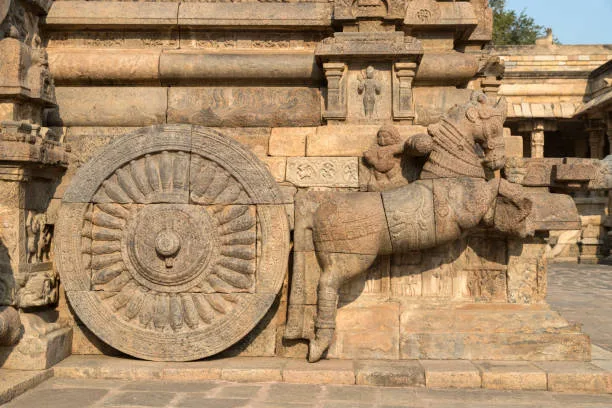
Located in Darasuram near Kumbakonam, the Airavatesvara Temple is a stunning example of Chola architecture and a proud UNESCO World Heritage Site. Built in the 12th century by Rajaraja Chola II, this temple is dedicated to Lord Shiva and is celebrated for its fine detailing and artistic elegance.
One of its most iconic features is the stone chariot-shaped mandapa, which appears to be pulled by horses—an architectural marvel carved from stone. The temple’s pillars are richly decorated with intricate carvings that depict scenes from Hindu mythology, showcasing the unmatched skill of Chola artisans. Another fascinating highlight is the musical steps—when tapped, each step produces a different note, adding a magical touch to the temple’s design.
Despite being smaller than its sister temples at Thanjavur and Gangaikonda Cholapuram, Airavatesvara stands out for its refined craftsmanship and poetic stonework that continues to captivate visitors and historians alike.
4. Tiruvalisvaram Temple (Tirunelveli District)
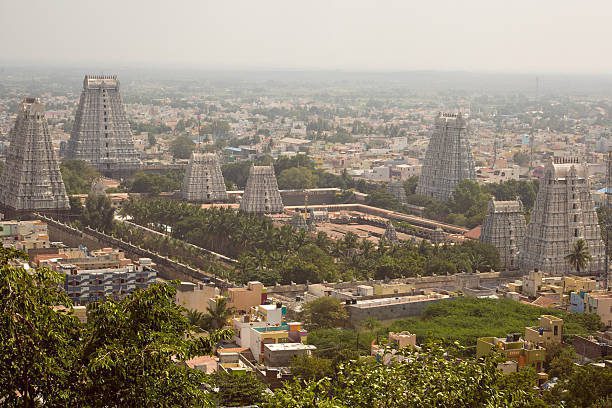
Tucked away in the Tirunelveli district of Tamil Nadu, the Tiruvalisvaram Temple is a true hidden gem from the Chola era. Built in the early 10th century by Raja Raja Chola I, this temple may not be as famous as its grander counterparts, but it shines with quiet elegance and historical depth.
The temple is known for its spacious pillared hall, where each column is adorned with intricate carvings that reflect the artistic brilliance of the time. Its walls are etched with ancient stone inscriptions, offering a fascinating glimpse into the temple’s origins, royal patronage, and the lives of those who once worshipped here.
Surrounded by lush greenery and set beside the Gadananathi River, Tiruvalisvaram offers a peaceful retreat for history lovers and spiritual seekers alike. It’s a perfect example of how beauty and legacy often lie off the beaten path.
5. Konerirajapuram Temple (Konerirajapuram)
Nestled in the quiet village of Konerirajapuram in Tamil Nadu, this ancient temple is a hidden treasure of Chola artistry. Built during the reign of the Chola dynasty, the temple is best known for its towering bronze idol of Lord Nataraja, which stands over 7 feet tall—making it one of the largest of its kind in India.
What makes this sculpture truly remarkable is its fine detailing and lifelike features, crafted using the traditional panchaloha (five-metal) technique. According to legend, the idol was divinely manifested, adding a layer of mystique to its already awe-inspiring presence.
The temple itself is a stunning showcase of Chola architecture, with perfectly aligned structures, intricate stone carvings, and a serene ambiance that transports visitors back in time. From the symmetrical layout to the richly sculpted pillars, every element reflects the artistic brilliance of the era.
6. Nageswaran Temple (Kumbakonam)
Located in the temple town of Kumbakonam, Nageswaran Temple is a stunning example of early Chola architecture and scientific ingenuity. Built in the 9th century by Aditya Chola, this temple is often called Surya Kottam for a fascinating reason—its sanctum is perfectly aligned so that sunlight falls directly on the main deity during the Tamil month of Chithirai (April–May).
What truly sets this temple apart is its chariot-shaped sanctum, a rare architectural feature that mirrors the design of the Sarangapani Temple. This design not only adds visual grandeur but also reflects the Cholas’ deep understanding of astronomy and engineering. The temple’s orientation and structure were carefully planned to capture solar movement, showcasing a blend of spirituality and science that was centuries ahead of its time.
With its intricate carvings, towering gopurams, and celestial alignment, Nageswaran Temple is more than a place of worship—it’s a timeless tribute to the Chola dynasty’s architectural brilliance.
7. Thirubhuvanam Temple (Thirubhuvanam)
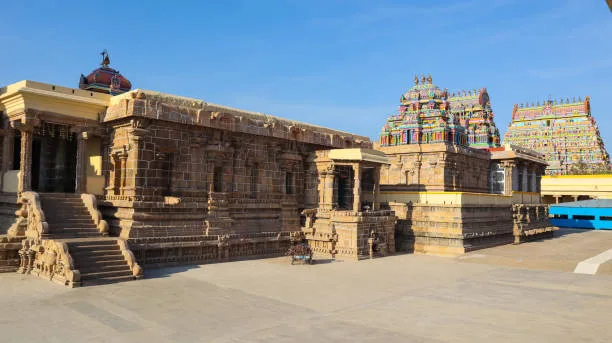
Located in the town of Thirubhuvanam near Kumbakonam, the Kampaheswarar Temple is a lesser-known yet extraordinary gem from the later Chola period. Built by Kulothunga Chola III in the 12th century, this temple stands as a testament to the dynasty’s final phase of architectural brilliance.
What makes this temple truly special is its exquisite stone carvings, which cover nearly every surface—from the towering vimana to the intricately sculpted pillars. The temple’s design reflects a refined mastery of Dravidian architecture, with symmetrical layouts, detailed mythological scenes, and a soaring sanctum that reaches nearly 120 feet.
Inside, you’ll find depictions of deities, celestial beings, and epic tales from the Ramayana and Mahabharata—all carved with astonishing precision. The temple also features a rare shrine for Sharabha, a fierce form of Shiva, adding to its spiritual and artistic uniqueness.
Though it may not draw the same crowds as Thanjavur or Gangaikonda Cholapuram, Thirubhuvanam Temple offers a quiet, awe-inspiring experience for those who appreciate the finer details of Chola craftsmanship.
8. Vijayanagara Temple (Kanchipuram)
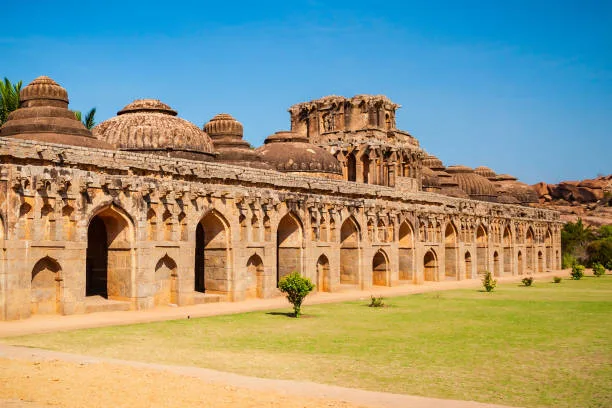
Though rooted in the Chola period, the Vijayanagara Temple beautifully reflects a blend of Chola elegance and Vijayanagara innovation. Located in South India, this temple stands as a rare architectural bridge between two powerful empires that shaped the region’s cultural legacy.
The temple is best known for its towering gopurams (gateway towers), which rise dramatically above the complex and are adorned with detailed carvings of gods, dancers, and mythical creatures. These grand structures echo the Vijayanagara style, known for its monumental scale and intricate ornamentation.
Inside, visitors are greeted by finely sculpted pillars and narrative friezes, showcasing the Cholas’ mastery of stonework. The temple’s layout and decorative elements reflect a deep understanding of sacred geometry, while its peaceful courtyards and sanctums offer a serene spiritual atmosphere that continues to draw pilgrims and history lovers alike.
This temple isn’t just a place of worship—it’s a living canvas of South India’s artistic evolution.
Final Thoughts
The Chola dynasty created some of the most beautiful and lasting temples in Indian history. These temples reflect their deep devotion, artistic skills, and advanced knowledge of science and engineering. If you’re planning a heritage trip in Tamil Nadu, these eight Chola temples are definitely worth visiting.
From their tall temple towers to peaceful water tanks, every corner of these temples tells a story. Visiting them feels like stepping back in time and seeing the divine expressed through stone and design.
FAQs
1. What makes Chola dynasty architecture unique?
Chola dynasty architecture is unique for its towering vimanas, detailed stone carvings, and the use of granite in large-scale temples. Their mastery in bronze sculptures, particularly the Nataraja form of Lord Shiva, is also a highlight.
2. Which is the largest Chola temple?
The Brihadeeswarar Temple in Thanjavur is the largest and most famous Chola temple. It is celebrated for its massive vimana and detailed sculptures, making it a UNESCO World Heritage Site.
3. What materials were used in Chola temples?
The Chola dynasty primarily used granite for temple construction, which was carved into intricate sculptures and architectural elements. Bronze was also used extensively for making statues and ornaments.
4. What is the significance of Nandi sculptures in Chola temples?
Nandi, the sacred bull of Lord Shiva, symbolizes strength and devotion. The large Nandi sculptures placed in front of Chola temples serve as guardians of the sanctum and are artistically significant.
5. Why should I visit Chola dynasty temples?
Visiting Chola dynasty temples offers a unique glimpse into India’s rich cultural heritage and architectural ingenuity. These temples are not just religious sites but also stand as historical landmarks that showcase the artistic and engineering achievements of the Chola dynasty.
Explore More
If Chola dynasty architecture fascinates you, there’s much more to explore! Head over to Xplro for more travel guides that uncover India’s rich cultural heritage. From the architectural marvels of the Chola dynasty to the Mughal masterpieces, we’ve got you covered. Start planning your next trip with our expertly curated travel blogs!






